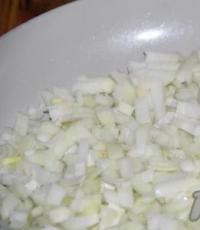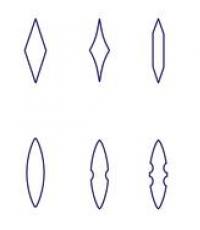Theme: plants and animals in winter. Animals at different times of the year. You can’t pull it out without difficulty and
Goal: to introduce students to the changes that have occurred in the life of plants and animals with the arrival of winter.
Lesson objectives:
1. Teaching children to recognize trees in winter by their external features; winter traces of animals and birds.
2 . Development of students' thinking, imagination, ability to imagine, generalize, prove.
3 . Instilling in students a caring attitude and love for all living things.
Equipment: pictures depicting forest animals (children's drawings), encyclopedias “Miracle - Everywhere”, “The World of Animals and Plants”, Yu. Nagibin “Winter Oak” (text used during correspondence excursion), phonogram by A. Vivaldi “Winter”.
During the classes
- Psychological mood of students.
- Reinforcing the material covered.
(Student reads a poem)
White fluffy snow
Spinning in the air.
And the ground is quiet
Falls, lies down.
And in the morning snow
The field turned white
Like a veil
Everything dressed him.
Dark forest with a hat
Covered up weird
And fell asleep under her
Strong, unstoppable.
We listened to a wonderful poem by I. Surikov .
- What is this poem about?
Let's remember the last lesson. What interesting things did you remember?
(... we went to visit winter, looked at drawings and photographs taken in winter, guessed riddles...)
- What was the most important thing we talked about, discussed, observed?
(...winter changes in inanimate nature)
– Does everyone remember what changes occur in inanimate nature with the onset of winter? Now we will check this. I invite you to solve riddles about natural phenomena, determine whether this phenomenon is a winter phenomenon and prove it.
1.
He flies in a white flock
And sparkles on the fly.
He melts like a cool star
On the palm and in the mouth.He is both white and furry,
And fluffy like a bear.
Scatter it with a shovel,
Call him, answer!
(Snow)So, snow or snowfall is a winter natural phenomenon, what do you think?
- Why doesn't it snow at other times of the year? (...only in winter the air temperature is low, water vapor freezes and turns into snowflakes).
2.
So that autumn doesn't get wet,
Not soggy from water,
He turned puddles into glass,
Made the gardens snowy.
(Freezing)
- Does this natural phenomenon belong to winter?
3.
What a miracle - beauty!
painted gate
Appeared on the way.
You can’t drive into them or enter them!
(Rainbow)
- Is this a winter natural phenomenon?
- Why?
4.
Not snow and not ice,
And with silver he will remove the trees.
(Frost)
5.
Lukerya scattered
Silver feathers,
Spun it, swept it up
The street has become white!
(Blizzard)
6.
Who beats on the roof all night,
Yes, he knocks.
And he mutters and sings.
Lulls you to sleep? ( Rain)
- Is this a winter natural phenomenon? Why?
7.
Continue the poem by Valentin Berestov
Doesn't go and doesn't go
Because …. ( black ice)
But it falls beautifully,
Why isn't anyone happy?!
So guys! Let's once again list the natural phenomena that occur in winter. ( Snowfall, frost, hoarfrost, blizzard, sleet)
Now I’m convinced that you remember the material from the last lesson well.
State the topic and purpose of the lesson.
- Working on new material.
1. Changes in plant life.
- How did changes in inanimate nature (which we just talked about) affect plant life?
Many plants have a so-called rest period, mainly in winter. Deciduous trees, such as birch, maple, aspen, etc., shed their leaves in the fall because at this time there is not enough sunlight for the formation of nutrients in the leaves. In winter they rest, and in spring new leaves appear on them.
- Tell me, do all trees shed their leaves for the winter? (... no, spruce, pine, do not shed their leaves)
- What are these trees called? (... evergreens) (...conifers)
Evergreen trees remain leafless for several years and lose their leaves gradually as new leaves grow, so they are never bare.
Guys, I read all this data in the encyclopedia “ Living world” and I advise you to read this interesting and informative book.
And now, I invite you all to excursion into a fabulous winter forest...
(The phonogram by A. Vivaldi “Winter” sounds)
Close your eyes and imagine that you find yourself in a world of peace and special silence. This is a fabulous winter forest. Everything around is white, the trees are all covered with snow down to the smallest twig. Only in the heights do the tops of the birches turn black, their thin branches seem to be drawn in ink on the blue surface of the sky. Only snow-white trunks with black specks indicate that these are birches. Sometimes the trees part, revealing cheerful sunny meadows to us. We look around and see: all the trees are so similar to each other that it’s impossible to tell them apart! We continue along a barely noticeable path. And suddenly in the middle of the clearing in white sparkling clothes stands an oak tree, huge and majestic. The trees seem to have respectfully parted to allow him to unleash his full force. Its lower branches spread out like a tent over the clearing. The foliage, having dried out in the fall, barely flew around. The oak tree is covered to the very top with dry brown leaves sprinkled with snow.
The winter forest is fabulously beautiful, but it’s time for us to return.
- Did you enjoy this excursion?
- What feelings did you experience while walking through a fabulous winter forest? (... joy, surprise, anticipation of something unusual…)
- Tell us what you saw in the winter forest?
- What seemed unusual to you? (... the trees are very similar to each other and are difficult to distinguish…) Why?
- What trees did you manage to distinguish? (... birch, oak)
Now we will turn to the textbook and read the article “ How to recognize trees in winter” p.112-113.
(Read the text aloud, paragraph by paragraph)
- Which tree(s) are easiest to recognize in winter? (... birch, oak, spruce, pine)
- By what signs do we recognize a birch? And the oak?
- What is the difference between spruce and pine? (... spruce needles grow one at a time, and pine needles grow two at a time; spruce cones are long, and pine cones are short, round, with scales).
(Showing samples of cones)
To make it more clear to you, open p. 108 (textbook). Help Seryozha and Nadya identify the trees.
(We consider and remember)
We visited a fabulous winter forest, learned to recognize trees in winter, talked about changes in plant life in winter, but we did not visit a field. After all, there are plants there too. Imagine if we lifted the winter “duvet” blanket so you and I could see? (... green sprouts of winter crops)
Look at p.108. Under the snow, the guys found herbaceous plants: strawberries, hoofed grass, cereals.
- Why do you think these plants do not die from frost? (...their root system is adapted in such a way that it is able to feed plants even in winter...)
Physical exercise.
- Do some physical exercises.
- “Away with anxiety and away with laziness - we are friends for the whole day”
2. Changes in the lives of animals
- Do you think the changes that occurred in winter in inanimate nature and in plant life somehow affected the life of animals?
- How has the life of animals changed with the arrival of winter? (... there is less food, many animals hibernate, the fox, the hare “put on warm coats”...)
To get acquainted with the life of animals in winter in more detail, I suggest you watch the video film that the guys prepared based on G. Ladonshchikov’s poem “Winter Pictures”. This oral video is about the life of forest animals in winter.
(The student reads the poem and shows the corresponding picture that he drew himself, then another student comments on this episode)
The sun warms the earth weakly,The frost crackles at night.
In the snow woman's yard
The carrot nose turned white.
Winter evening, the sky is overcast with gray clouds. The stars light up. There are few people on the street, everyone is rushing home, covering their faces from the deepening frost. The yards are empty. There are trees covered with frost. The snow woman remains alone in the yard. Her nose, like a carrot, turns slightly white from the frost.
Under a birch tree on a hill
The old hedgehog made a hole
And under the leaves lie
Two young hedgehogs.
There is a forest outside the city. There is silence there, everything is covered with snow. There is a lonely birch tree on the hill. Its branches hung straight down to the snowdrifts. There was a small mound of snow right next to the birch tree trunk. I wonder what's there? It turns out there is a hedgehog hole there. In the fall, the hedgehog loves to eat well: it is necessary to accumulate fat for the winter so that it has something to eat during hibernation. For the winter, the hedgehog settles in a secluded place in dry leaves and grass: it curls up into a ball and sleeps until spring.
The squirrel hid in a hollow
It is both dry and warm.
Stock of mushrooms and berries
So much that you couldn’t eat it in a year.
A nimble animal is jumping along the upper branches of an old tree. This is a squirrel. And on this tree she has her own house - a hollow. The squirrel darted into the hollow. Let's take a look there too. The hollow is not very large, but dry. It is lined with moss and dry leaves, and it is warm for the squirrel. Usually they have not one house, but several - for sleeping, for wintering, for breeding squirrels. It happens that in severe frosts several squirrels sleep in one nest, warming each other and plugging the entrance with moss. There are squirrel supplies in a separate place. But we know that the squirrel hung a lot of mushrooms throughout the forest, and buried a lot of nuts in different places (forest “storerooms”) under the trees. Often other forest animals feed on its reserves.
Cautious fox
I went to the stream to drink,
Bent over, and the water
Still and solid.
A beautiful animal in a bright red coat with a fluffy tail ran out onto the bank of a forest stream. The fox decided to drink water. She lowered her muzzle and hit the ice with her black nose. But due to severe frosts, the water in the stream turned to ice. The fox will have to chew the snowball instead of water. In winter, a fox has a home under any bush: he curls up in the snow, covers his nose with his fluffy tail so as not to freeze, and sleeps.
The scythe has no den,
He doesn't need a hole:
Legs save you from enemies,
And from hunger - bark.
In the deep snow, a hare moves in leaps and bounds from one bush to another. In winter it turned white. His fur coat is warm and thick. He doesn't have his own home. The hare sleeps in the snow and hides from its enemies in the snow. The hare does not make provisions for the winter. It gnaws at the bark of young aspen trees and gnaws on thin twigs. A dry branch cracked in the forest. The hare became wary and pricked up his long ears. So he disappeared into the forest. Only bizarre footprints remained in the snow.
Under a snag in a windfall
The bear sleeps as if in a house
He put his paw in his mouth
And, like a little one, he sucks.
In the fall, having grown fat, the bear looks for a den. For a long time, like a hare, he winds and confuses his tracks, so that no one knows where he settled down for the winter. A female bear winters together with her cubs in the same den. In winter, in January or February, older cubs have little brothers or sisters, very tiny, the size of a mitten.
- Did you guys like our spoken word video?
- What interesting things have you learned about animal life?
In winter, every animal will definitely “sign” in the “winter book” of the forest, i.e. will leave its traces. Look at the animal tracks on p. 109. Whose traces are these?
- Winter is a very serious test for animals and plants. How can you and I help animals? What about plants? ( Cover winter plants with dry leaves, such as strawberries, garlic..., wrap the trunks of young trees...)
- Do you think trees are friends with animals?
- Do you want to know who the spruce is friends with? Open p.110 ( teacher reads)
- Look at the drawing. What birds and animals does spruce provide food and shelter?
- What could happen to the animals of the forest if people cut it down?
(Educational moment)
- Lesson summary.
- Does the active life of animals and plants continue in winter?
- What interesting things have you learned about the life of plants and animals in winter? pp. 108-109 (optional) draw pictures on the topics: “Winter Forest”, “Animal Life in Winter”.
Seasons play a huge role in the lives of animals. For them, each season is a period of specific activity. While a person can reschedule his plans or change his lifestyle, animals are not capable of this. Living according to the rules of nature is in their blood.
Spring
How animals welcome spring

Spring is a period of new life for all animals. After a long and calm winter, all representatives of the animal world begin to actively prepare for the onset of a hot summer.
Spring days in the life of animals are accompanied by a change in coat - from winter to summer. Squirrels change their gray skin to bright red. They can increasingly be found in parks. Squirrels jump through the trees in search of food.
Chipmunks wake up after hibernation. Outwardly, it can be confused with a squirrel, but the main difference is the five dark stripes on the back. Chipmunks have been stocking up on food since winter, before they hibernate. Therefore, with the arrival of spring, these animals are not puzzled by the search for what they can get enough of.
But bears, also hibernating in winter, do not care about what they will eat after a long sleep. Therefore, in the spring they come out of their dens in search of food.
For wolves, spring is the time when they breed. Little wolf cubs stay in their parents' den until they have the vision to navigate well in space. Being small, they are very similar to foxes, only the tips of their tails are not white, but gray.
Hares begin to shed, exchanging their winter white coat for a gray and less warm coat. Also, raccoon dogs, waking up after hibernation, change their color to a less noticeable one. The color of the coat is of great importance. In winter, the skins are white, this makes it possible to blend into the snow-white cover of the earth if a predator is hunting nearby. Gray wool also serves as a kind of camouflage in summer.
In early spring, hedgehogs wake up, because in April they have to breed.
Summer
Animal life in summer

Summer is the most favorable period in the life of animals. Long sunny days, warmth and plenty of food undoubtedly delight the animals. They are especially active at this time of year. They are not yet preparing for winter, but they are preparing their offspring for a harsh period. Therefore, animals are in constant search of food for their young in order to saturate them with useful substances and vitamins.
Herbivorous mammals sometimes leave their habitats because what they eat grows everywhere. Fresh juicy leaves allow them to stock up on useful substances for future use.
For birds, summer is a feast, because they can find delicacy absolutely everywhere. Midges, worms, caterpillars, fish - all this is their food in the summer. Birds are also assistants to gardeners. They eat all pests that can destroy the crop.
Despite the fact that summer is the most active period in the life of animals, there is one exception. Gophers prefer to rest on these warm days. And to saturate themselves with vital energy, they go hunting at night.
The most active animals in the summer are squirrels, wolves, bears, and various rodents. This time is also loved by: giraffes, camels, hyenas, cheetahs, monkeys and many others.
Autumn
Changes in the lives of animals in autumn

Autumn is a period of preparation for winter cold. Their life in winter depends on how they live the autumn, what they manage to do during this time. Furry, feathered, predators - everyone must take this preparation responsibly, because their own lives and the lives of their offspring are at stake.
Insects are the first to feel the arrival of cold weather. They begin to build burrows for themselves and look for shelter, which most often comes from fallen leaves or tree bark. This is where they will spend the entire winter.
Butterflies have their own way of surviving the cold period - they turn into pupae.
Also, toads, frogs, snakes and lizards are among the first to hide. Some frogs live closer to bodies of water so that when cold weather sets in, they can dive into them and sleep at the bottom until warm days return. But toads, on the contrary, hide on land. Their winter shelter is tree roots or rodent burrows.
In the autumn, forest animals begin to eat frequently and nutritiously, because they need to accumulate a supply of substances and fat that will help them survive in severe frosts.
And squirrels, mice and moles begin to stock up on food for future use. They bring as many nuts, berries and cones into the house as possible.
Most animals go through the natural process of pre-winter molting. They again change their skins to warmer and less attractive ones.
Winter
How animals winter

As a rule, only those animals that are capable of this hibernate. And those who are categorically afraid of the cold flee to the southern regions.
The life of animals freezes in winter. In the fall, everyone prepared shelters for themselves, in which they now live. The cold is not terrible for those warmly dressed in their furs: hares, squirrels, arctic foxes, foxes, wolves, moose and many others.
And some simply fall asleep: raccoons, marmots, chipmunks, badgers, bears and other animals.
Mollusks bury themselves in mud for the winter. Wasps, bumblebees, and tarantulas also prepared minks for themselves.
Newts hide on the shore, in a thick layer of fallen leaves or branched tree roots.
Gophers, hamsters and jerboas prefer to sleep in winter.
At the end of August - beginning of September, gophers, hamsters, and jerboas climb into their deep holes and fall asleep.
With the approach of cold weather, numerous forest inhabitants begin to prepare for the winter. In the process of evolution, representatives of the animal world have developed certain methods that help them survive severe frosts and lack of solar heat. In addition, most animals also suffer from a lack of food in winter, this is especially true for herbivores, although predators also have a hard time.
All living creatures have certain characteristics of survival in winter, and this applies not only to animals, but also to perennial plants.

For example, it is well known that bears hibernate in the cold season until spring, however, this method of wintering is not unique to them. In the same way, hedgehogs, badgers, hamsters and many other living creatures prefer to “sleep through” the winter, so in winter nature seems to freeze, awaiting the onset of more favorable conditions for life.

However, many animals living in forests remain quite active in winter, although, naturally, they have to significantly reduce energy consumption compared to the warm season.


For example, moose try to move much less in winter, use tree branches and bark for food, and look for young shoots of plants that may be hidden under the snow. Of course, the flora in winter is sparse, so moose lose weight and often live from hand to mouth, however, this does not prevent them from successfully overwintering.

With the onset of winter, foxes, hares and other animals become warmer and grow thicker fur, which allows them to stay warm even in severe frosts. In addition, during severe frosts, instinct tells animals to burrow deeper into snowdrifts, because snow helps maintain the required body temperature.

Finally, it is worth mentioning how plants overwinter, because without this the description of the winter forest will be incomplete. Trees are protected from frost by thick bark, many plants hide from the cold under snow cover, some plants die, leaving only a viable rhizome, from which a new plant will grow in the spring... As we see, our nature is wise and diverse, it can adapt to any weather conditions, and The task of man in this situation is to do everything possible to protect wildlife, first of all, those animals and plants that are listed in the Red Book.
Video: Winter. Winter's Tale. Seasons. Winter forest (Relax.)
A walk through winter to the music of Francis Lai

Beautiful photos and pictures of winter nature:




GBOU Novozybkov boarding school
Prepared by:
Vlasenko E.M.
teacher of the highest category


- What time of year is it now?
- Name the winter months.
- What is the weather today?
- What changes have occurred in
- What kind of precipitation occurs in winter?
nature with the arrival of winter?


Winter is the coldest time of the year.
The sun goes low.
Short days are established
and long nights.
The soil and water bodies freeze.
Frosts are coming. The ground is covered with snow. At this time of year we experience fog, snowfall, ice,
frost, ice, hoarfrost, blizzard.
Winter is a difficult period in the life of hibernating animals. The forest was covered with snow. The trees are all covered in fluffy snow, sparkling in the rays of the sun.
But life is not easy for animals in the winter forest. It’s not easy to get food from under the snow and conserve energy.
The foxes hid in their warm holes.
Squirrels live by gnawing nuts hidden in reserve in the fall. Bears in dens suck paws. Wolves stalk their prey.


The squirrel builds its nest in the forks of branches or in the hollows of trees. By winter, the squirrel has insulated its nest, which serves as reliable protection from bad weather. In severe frosts, squirrels do not run through the forest; they hide in nests. By winter, the squirrel makes food supplies.
How does a squirrel live in winter?

What is the squirrel hiding in the hollow?
ishkish
bumps
Eriokh
nuts
iyrbg
mushrooms
dogyya
berries

- What squirrel?

Continue the proverb about work:
Do you like to ride -
You can’t pull it out without difficulty and
Skill and labor
Master's Case
Don't take on too many things
Why does the soul lie?
Under a lying stone and
love to carry sleighs too.
fish from the pond.
everything will be crushed.
fears.
and excel in one thing.
Hands will be attached to that.
water doesn't flow.

Who else is a wild animal?
making supplies for the winter?



Hares have hind legs that are stronger than their front legs. He runs on loose snow on his furry paws easily, like on skis.
He sleeps lightly, dozes half asleep with his eyes open, closing them only for a minute. During heavy snowstorms and snowfalls, it hides in shallow holes and bushes.

- Follow the path of the hare.
- Solve the examples and connect the stumps in ascending order.


A den is a hole dug somewhere under the roots of a tree, lined with grass. The bear lies down with its head towards the exit, covers its muzzle with its paw and sleeps.
At this time he does not eat food,
and lives off accumulated fat.

A game " Which branch are the kids from?
pine
aspen
birch
Rowan

Hedgehogs, raccoons, badgers, and bears sleep in dens and burrows.
What other animals do you know that, like a bear, hibernate?



In winter, due to lack of food, wolves
become less careful. Sometimes they go out hunting even during the day, come close to villages, and attack livestock.

Wolves have a good sense of smell and
They can hear even faint sounds. This helps them find prey and their strong legs help them chase running animals.

Wolves hunt in packs in winter and attack elk and wild boar.
How do wolves hunt in winter?

Hello! Did you recognize me?
I'm not alone in the forest...



where the characters are wolves.
Fox sister and gray wolf.








Like a cat, he loves to play with his prey.
In winter you can see a fox sniffing the snow. In fact, she tracks mice by smell under the snow.
What is a fox like in fairy tales?

Guess the puzzles.
tassel
paints

cover

the equation
root

dictionary
denominator


Foresters feed the animals.
How do foresters help animals?


Young aspen trees are cut down for moose,
elk also love rowan and pine branches. Leave it for the wild boars
root vegetables: beets, rutabaga, turnips, acorns.

To help the fish in winter, in the ice
make holes. And so that the water quickly
didn’t freeze, they put bunches in it
straw and sprinkled with snow. For the birds
hang feeders and leave them in them
feed.




What new and interesting things did you learn?
about animal life in winter?

Well done !




